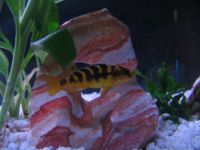Bumblebee Cichlid (Pseudotropheus crabro)
From The Aquarium Wiki
(Redirected from Bumblebee Cichlid)
Bumblebee Cichlid
Pseudotropheus crabro
114 Litres (30 US G.)
10.2-15.2cm (4-6 ")
Freshwater
7.5 - 8.6
25.6-27.8°C (78 -82 °F)
15-20 °d
1:3 M:F
5-8 years
Family
Cichlidae
Contents
Additional names
- Bumblebee Cichlid, Hornet Cichlid, Bumblebee Mbuna
Additional scientific names
- Melanochromis crabro, Maylandia crabro
Sexing[edit]
- Females are yellow with black stripes and males are black with darker stripes or totally black. Although the females can become totally black at will and the males can even show some yellow if desired, but only for a short time.
Breeding[edit]
- A maternal mouth brooder. The males will turn jet black then shake and circle when trying to attract a mate. The female will lay eggs on a flat rock. The female will hold the eggs for 18 to 21 days.
Tank compatibility[edit]
- Aggressive towards it's own kind and other fish. Crabro will kill other males and even sometimes females if there is not enough room or places for the victim to hide.
Diet[edit]
- In nature this fish is a cleaner fish of the catfish Bagrus meridionalis. Because this fish eats fish lice and insect larvae in the wild it could benefit from a more protein rich diet than most Mbuna.
Feeding regime[edit]
- Feed once or twice a day with no more food than the fish can eat in 2-5 minutes.
Environment specifics[edit]
- Originates from a deep rocky habitat of Lake Malawi, Africa. Keep in a rocky set up with plenty of caves provided. If a large cave is introduced this fish will almost certainly take it up as its home.
Behaviour[edit]
- In nature this fish has the ability to turn almost completely black so that it can sneak by the Bagrus meridionalis and eat it's eggs. When the fish is in the black and yellow configuration it is allowed to eat the parasites and lice off of the catfish. This also will happen some times in the aquarium when it is feeling especially aggressive. It is quite amazing how quickly this fish is able to change it's colour. It has been observed doing a complete colour change in under a second.
Identification[edit]
- Typical Pseudotropheus but can be a bit more elongated than most. Females are yellow with black stripes and males are black with darker stripes or totally black. Originally typed by Ribbink and Lewis in 1982.
Pictures[edit]
External links[edit]
- Fishbase (Mirrors:
 )
)
